Swiss Alps

The Alpine region of Switzerland, conventionally referred to as the Swiss Alps,[1] represents a major natural feature of the country and is, along with the Swiss Plateau and the Swiss portion of the Jura Mountains, one of its three main physiographic regions. The Swiss Alps extend over both the Western Alps and the Eastern Alps, encompassing an area sometimes called Central Alps.[2] While the northern ranges from the Bernese Alps to the Appenzell Alps are entirely in Switzerland, the southern ranges from the Mont Blanc massif to the Bernina massif are shared with other countries such as France, Italy, Austria and Liechtenstein.
The Swiss Alps comprise almost all the highest mountains of the
Since the
Geography

The Alps cover 60% of Switzerland's total 41,285 square kilometres (15,940 sq mi) surface area, making it one of the most
The glaciers of the Swiss Alps cover an area of 1,220 square kilometres (470 sq mi) — 3% of the Swiss territory, representing 44% of the total glaciated area in the Alps i.e. 2,800 square kilometres (1,100 sq mi).
The Swiss Alps are situated south of the
The Alpine
Ranges
The Alps are usually divided into two main parts, the
Western Alps
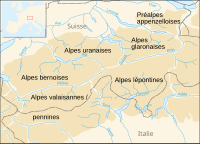
| Location | Range | Cantons, Country | Notable peaks | East limit |
|---|---|---|---|---|
| From west to east, north of Rhône and Rhine | ||||
| Bernese Alps | Valais
|
Finsteraarhorn, Aletschhorn, Jungfrau, Mönch, Eiger, Lauteraarhorn | Grimsel Pass | |
| Uri and Emmental Alps | Valais )
|
Dammastock, Titlis, Brienzer Rothorn, Pilatus, Napf | Reuss | |
Schwyzer Alps
|
Graubünden, Lucerne
|
Mythen
|
Seeztal | |
| Appenzell Alps | Zurich )
|
Säntis, Churfirsten | Rhine | |
| From west to east, south of Rhône and Rhine | ||||
| Chablais Alps | Valais, France
|
Dents du Midi | Arve | |
| Mont Blanc massif | Aiguille d'Argentière | Col Ferret | ||
| Pennine Alps | Valais, Italy
|
Monte Rosa, Weisshorn, Matterhorn | Simplon Pass | |
| Lepontine Alps | Graubünden
|
Monte Leone, Rheinwaldhorn | Splügen Pass |
Eastern Alps
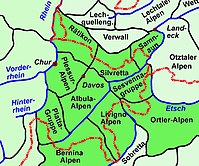
| Location | Range | Notable peaks |
|---|---|---|
| From west to east, north of Mera and Inn
| ||
Oberhalbstein
|
Piz Platta | |
Plessur
|
Aroser Weisshorn | |
Albula
|
Piz Kesch, Piz Lunghin | |
| Rätikon | Schesaplana | |
Silvretta
|
Piz Linard, Piz Buin | |
| Samnaun Alps | Muttler | |
| From west to east, south of Mera and Inn
| ||
| Bregaglia | Cima di Castello, Piz Badile | |
| Bernina | Piz Bernina, Piz Roseg | |
Livigno
|
Piz Paradisin | |
| Ortler Alps | Piz Murtaröl | |
Sesvenna
|
Piz Sesvenna |
Hydrography
Rivers
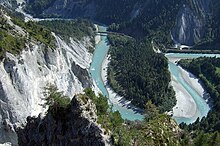
The north side of the Swiss Alps is drained by the
Lakes
Since the
Hydroelectricity Impacts due to Glacial Melting
Switzerland has been using this concerning transition in climate as a positive opportunity to develop new innovations and to change the ways that energy is being produced in the country. Switzerland depends on the use of hydroelectricity to power nearby communities, but as glaciers melt and stop refreezing, the melting that creates the energy ceases to exist. Researchers have been evaluating how the topography will change as the glaciers begin to decrease and they are looking more deeply into potential construction costs, energy production, and future problems they might encounter with these new developments. Switzerland is one of many countries that need to begin to think about the future of energy production in response to climate change. Switzerland is paving the way for a new wave of innovation and creative problem solving that the rest of the world will eventually need to follow.[10]
Land elevation
The following table[11] gives the surface area above 2000 m and 3000 m and the respective percentage on the total area of each canton whose high point is above 2000 metres.
| Canton | Land above 2000m in km2 | Land above 2000m in % | Land above 3000m in km2 | Land above 3000m in % |
|---|---|---|---|---|
Appenzell Ausserrhoden
|
1 | 0.4 | 0 | 0 |
Appenzell Innerrhoden
|
4 | 2.3 | 0 | 0 |
| Bern | 887 | 15 | 100 | 1.7 |
| Fribourg | 14 | 0.8 | 0 | 0 |
| Glarus | 213 | 31 | 4 | 0.6 |
Graubünden
|
4296 | 60 | 111 | 1.6 |
| Lucerne | 4 | 0.3 | 0 | 0 |
Nidwalden
|
20 | 7 | 0 | 0 |
Obwalden
|
66 | 13 | 1 | 0.2 |
| Schwyz | 69 | 8 | 0 | 0 |
St. Gallen
|
184 | 9 | 1 | 0.05 |
Ticino
|
781 | 28 | 2 | 0.07 |
| Uri | 562 | 52 | 19 | 1.8 |
Valais
|
2595 | 50 | 697 | 13 |
Vaud
|
92 | 3 | 1 | 0.03 |
| Switzerland | 9788 | 24 | 936 | 2.3 |
Monitoring glacial changes over time
PERMOS (The Swiss Permafrost Monitoring Network) is an operational monitoring service, and its main goal is to create long-term scientific documentation of the permafrost changes in the Swiss Alps. To accurately represent the current conditions of the Alps, the network records permafrost temperatures and thermal changes in boreholes, the bottom temperature of the snow cover, ground surface temperature, and the development of snow cover. The network additionally takes air photos periodically from selected areas. These monitoring strategies continue to develop as new research and data are recorded over time.[12] The glaciers in the Swiss Alps have lost around half their volume during the last 90–120 years.[13][14]
Geology

The composition of the great tectonic units reflects the history of the formation of the Alps. The rocks from the
With some exceptions, the Alps north of Rhône and Rhine are part of the Helvetic Zone and those on the south side are part of the Penninic nappes. The Austroalpine zone concerns almost only the Eastern Alps, with the notable exception of the Matterhorn.
The last
Environment and climate
To protect endangered species some sites have been brought under protection. The
Climate zones
As the temperature decreases with altitude (0.56 °C per 100 meters on yearly average), three different altitudinal zones, each having distinct climate, are found in the Swiss Alps:
- Subalpine zone

The
- Alpine zone
The
- Glacial zone
The glacial zone is the area of permanent snow and ice. When the steepness of the slope is not too high it results in an accumulation and compaction of snow, which transforms into ice. The glacier-formed then flows down the valley and can reach as far down as 1,500 meters (the Upper Grindelwald Glacier). Where the slopes are too steep, the snow accumulates to form overhanging seracs, which periodically fall off due to the downward movement of the glacier and cause ice avalanches. The Bernese Alps, Pennine Alps, and Mont Blanc Massif contain most of the glaciated areas in the Alps. Except for research stations such as the Sphinx Observatory, no settlements are to be found in those regions.
Impact of glacial melting
Due to the change in weather patterns, the summers are expected to continue getting warmer and drier, while the winters are expected to become moister. This change in the weather increases the chances of flooding with heavier rainfall, the melting of permafrost zones, a change in the geography and wildlife, and the occurrence of more deadly rock slides. Furthermore, natural hazards are occurring more frequently, such as floods, avalanches, and landslides. Additionally, the water supply that the glaciers originally provided is on the decline, which is problematic for producing energy, agricultural practices, and other human use. Finally, the glacial melting puts the economy at risk because there will be less incoming financial revenue from the tourism and recreation services that these glaciers and ecosystems typically provide. All of these impacts will disrupt the nearby communities and require that updated infrastructure and safety measures be put into place to prevent mass destruction. [16] [17]
Travel and tourism
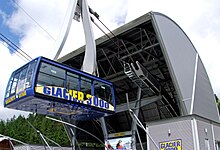
Tourism in the Swiss Alps began with the first ascents of the main peaks of the Alps (Jungfrau in 1811, Piz Bernina in 1850, Monte Rosa in 1855, Matterhorn in 1856, Dom in 1858, Weisshorn in 1861) mostly by British mountain climbers accompanied by the local guides. The construction of facilities for tourists started in the mid-nineteenth century with the building of hotels and mountain huts (creation of the Swiss Alpine Club in 1863) and the opening of mountain train lines (Rigi in 1873, Pilatus in 1889, Gornergrat in 1898). The Jungfraubahn opened in 1912; it leads to the highest railway station in Europe, the Jungfraujoch.
Summer tourism
Switzerland enjoys a 62,000-km network of well-maintained trails, of which 23,000 are located in mountainous areas. Many mountains attract a large number of
Winter tourism

The major destinations for
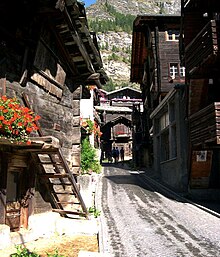
- Davos – Klosters GR
- Zermatt VS (car-free village)
- Engadin – St. Moritz GR
- Lenzerheide – Arosa GR
- BE(car-free villages)
- Les quatre vallées: Verbier – Nendaz VS
- LAAX: Flims – Laax GR
- VS (car-free villages)
- Les Portes du Soleil: Champéry – Morgins – Les Crosets VS and Avoriaz in France
- LenkBE
- St-Luc – ChandolinVS
- Gstaad: Chateau-d'Oex VD
- Silvretta Arena: Samnaun GR and Ischgl in Austria
- Crans MontanaVS
- Saas-Fee VS
Other important destinations on the regional level are
The first person to ski in Grindelwald, Switzerland was Englishmen Gerald Fox (a resident of Tone Dale House in England) who put his skis on in his hotel bedroom in 1881 and walked out through the hotel Bar to the slopes wearing them.[21]
Snow activities
Some major sporting activities include:
- Skiing
- Snowboarding
- Snow sled-biking
- Downhill snow Mountain Biking
- Snowmobiling (as well as snowmobile tours and rides)
Climate change
Climate change is impacting European Alpine tourism due to the increasing number and intensity of natural hazards, and it is endangering the accessibility and infrastructure of tourism destinations. Melting glaciers are affecting the attractiveness of the Alpine landscape, increasing winter temperatures will result in a shorter skiing season, and these climate changes are limiting the amount of snow coverage produced. All of these climate and geographical factors are leading to a smaller number of visitors and reduced revenues which can have an intense economic impact on winter tourism. In response to these changes, Switzerland has turned to the production of
Transport

The Swiss Alps and Switzerland enjoy an extensive transport network. Virtually every mountain village can be reached by public transport, either by rail, bus, funicular, cable car, or usually a combination of them. The main companies of the coherently integrated public transport system are:
- Swiss Federal Railways (SBB CFF FFS)
- Rhaetian Railway (RhB)
- Matterhorn Gotthard Bahn (MGB)
- GoldenPass Line
- PostBus (PostAuto / CarPostal / AutoPostale / Auto da Posta)
Most of the mountain regions are within 1 to 3 hours travel of
The
The crossing of the Alps is a key issue at national and international levels, as the European continent is at places divided by the range. Since the beginning of industrialisation Switzerland has improved its transalpine network; it began in 1882, by building the
Toponymy
The different names of the mountains and other landforms are named in the
| English | German | French | Italian | Romansh | Examples |
|---|---|---|---|---|---|
| Mount | Berg, Stock | Mont | Monte | Munt, Cuolm | Gamsberg, Dammastock, Mont Vélan, Monte Generoso, Munt Pers |
| Summit | Gipfel | Cime | Cima | Tschima | Grenzgipfel, Cima di Gana Bianca, Tschima da Flix |
| Peak | Spitze | Pointe, Pic | Pizzo | Piz, Péz | Lenzspitze, Pointe de Zinal, Pizzo Campo Tencia, Piz Roseg |
| Needle | Nadel | Aiguille | Ago | Ago, Guila | Nadelhorn, Aiguille d'Argentière, Ago di Sciora |
| Horn | Horn | Corne | Corno | Corn | Wetterhorn, Corne de Sorebois, Corn da Tinizong |
| Tower | Turm | Tour | Torre | Tuor | Torrone Alto
|
| Head | Kopf | Tête | Testa | Tgau | Bürkelkopf, Tête Blanche |
| Ridge | Grat | Crêt | Cresta | Fil, Cresta | Gornergrat, Crêt du Midi, Fil de Cassons |
| Glacier | Gletscher, Firn | Glacier | Ghiacciaio | Glatscher, Vadret | Glatscher dil Vorab
|
| Valley | Tal | Val | Valle, Val | Val | Mattertal, Val d'Hérens, Valle Maggia |
| Pass | Pass, Joch | Col, Pas | Passo | Pass | Passo del San Gottardo
|
Also, a large number of peaks outside the Alps were named or nicknamed after Swiss mountains, such as the Wetterhorn Peak in Colorado or the Matterhorn Peak in California (see the Matterhorn article for a list of Matterhorns in the world).
The confluence of the Baltoro Glacier and the Godwin-Austen Glacier south of K2 in the Karakoram range was named after the Konkordiaplatz by European explorers.
See also
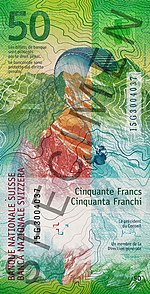
- Tourism
- Swiss Alpine Club
- Swiss Alpine Museum
- Haute Route
- Tour du Mont Blanc
- Monte Rosa tour
- Alpine Pass Route
- Trans-Swiss Trail
- Sport
- La Grande Odyssée
- Patrouille des Glaciers
- Lauberhorn Ski Race
- Trophée des Gastlosen
- Jungfrau Marathon
- Other
- The Alps (film)
- History of the Alps
- Transhumance in the Alps
- NRLA
- Exploration of the High Alps
Notes and references
- ^ (German: Schweizer Alpen, French: Alpes suisses, Italian: Alpi svizzere, Romansh: Alps svizras)
- ^ Ball, John (1873). The Central Alps. Longmans, Green & Co.
- ISBN 2-606-00294-6
- ^ Area defined by the Alpine Convention (website: alpconv.org Archived 2011-07-29 at the Wayback Machine)
- Barre des Ecrins and Gran Paradiso are the only over 4,000-metre ranges not shared with Switzerland. Distance retrieved from the Swisstopomap
- ^ According to the limit defined by the Alpine Convention
- ^ The Swiss Prealps should not be confused with the homonymous region defined by the SOIUSA classification of the Alps, with the Schilthorn as main summit.
- ^ Swiss Alps in German, French and Italian in the online Historical Dictionary of Switzerland.
- ^ "Dam Begun in Swiss Alps to be Europe's Highest." Archived 2023-07-27 at the Wayback Machine Popular Science, November 1929, p. 61
- ^ Hydroelectricity((www.nytimes.com/interactive/2019/04/17/climate/switzerland-glaciers-climate-change.html))
- ^ Die Kantone nach ihren höchsten Punkten Archived 2006-09-08 at the Wayback Machine (in German) Various highest and lowest elevation values by canton (village center, road or rail network, etc.)
- ^ PERMOS monitoring((www.permos.ch/downloads/permos00-02.pdf.))
- .
Total ice volume change since 1900 is −96 ± 13 km3
- .
This translates to a halving of glacier volume
- ^ "Nature parks swissworld.org". Archived from the original on 2009-06-04. Retrieved 2018-12-22.
- ^ Negative Impacts of Glacial Melting((lcluc.umd.edu/hotspot/glacial-retreat-alps))
- ^ Negative Impacts of Glacial Melting((www.myswissalps.com/aboutswitzerland/nature/environment/globalwarming))
- ^ There are in total 9 car-free villages members of the GAST (Gemeinschaft Autofreier Tourismusorte): Bettmeralp, Braunwald, Riederalp, Rigi, Saas-Fee, Stoos, Wengen, Mürren and Zermatt.
- ^ "Davos, la station la plus fréquentée de Suisse bilan.ch". Archived from the original on 2009-06-04. Retrieved 2009-06-08.
- ^ "Winter Sport Areas". search.ch. Archived from the original on 2015-11-09. Retrieved 2015-11-09.
- ^ "Skiing the Alps". Archived from the original on 2014-02-01. Retrieved 2014-01-28.
- S2CID 129703860.
Bibliography
- (in German and French) Heinz Staffelbach, Handbuch Schweizer Alpen. Pflanzen, Tiere, Gesteine und Wetter. Der Naturführer, Haupt Verlag, 2008, 656 pages (ISBN 978-2-940365-30-2).
External links
- Tourism
- General timetable of all public transport Archived 2009-01-15 at the Wayback Machine
- MySwitzerland.com
- SuisseMobile.com
- Scenic PostBus lines in the Swiss Alps[permanent dead link]
- MySwissAlps.com
- WalkingSwitzerland.com
- Maps
- Other

